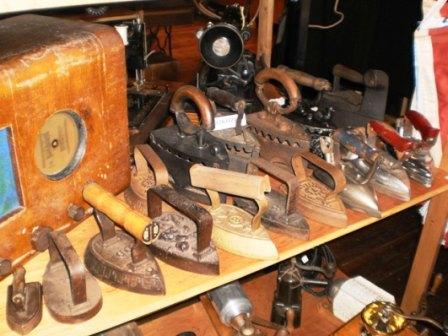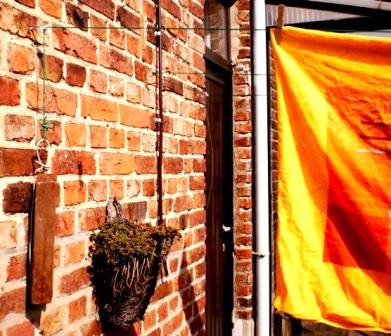A (clothing) iron (or flatiron) is the tool used to smooth after drying textile by heat and possibly some pressure and steam. The fibers are thus stretched so they look nice and smooth again. The heat also kills bacteria, making the operation would also have an hygienic function and sense for handkerchiefs, tea towels and towels.
 The irons have flat, smooth soles. It used to be heavy, slightly V -shaped blocks of cast iron with a handle. They were in a set of at least two pieces handled with oven mitts or cloths. They were heated on the stove, and used to turn. The (kitchen) table, with some cloths on it, served as substrate.
The irons have flat, smooth soles. It used to be heavy, slightly V -shaped blocks of cast iron with a handle. They were in a set of at least two pieces handled with oven mitts or cloths. They were heated on the stove, and used to turn. The (kitchen) table, with some cloths on it, served as substrate.
There were also hollow models that could be filled with glowing (char)coal.
To get rid off stiff materials or stubborn creases you use steam. To achieve this, they sprinkled some water on the workpiece, or used a damp cloth.
Previously also were flat stones or logs (with starch) used for ironing laundry.
Around 400 BC the Chinese have used already pans with charcoal or hot sand.
An ironing stone is a flattened solid glass sphere at the size of half a tennis ball. He is also called gloss stone (the Norwegian word 'slikji' = ironing). Polished stones were also used.
The Vikings brought beeswax in their woolen clothes to make them wind- and waterproof. The ironing of the "wax-coat 'was done with an ironing glass (ca. 9th century). The friction heat made the wax more or less liquid and pulling in the wool fabric.
Fully glazed earthenware ironing stones or shine stones come from approximately 1500.
Clothespins or pegs were made from 10 to 12 cm long beech wood slats or sticks, which vertically to slightly more than half are split (and sanded). This fork can be used as a clip to put laundry onto the wire.
A black and white movie from Volendam in 1933 shows how a housewife locally “unply” a twisted clothesline. She then puts an edge of a piece of clothing between the loose wires which return automatically twisting in shape and so hold the laundry without clothes pegs.
 A clothesline or washing lines can span between two walls or trees. You can also plant special high stakes, with the top T- shaped or a fork so that you can tighten 2 wires per pole. Due to the weight of laundry and the force of the wind, the wire will sag and / or the poles be pulled to each other. You can avoid this by tilting the poles outward, and hang to the top edge a cable in an angle of about 45 degrees on a sloping into the ground beaten anchor pole.
A clothesline or washing lines can span between two walls or trees. You can also plant special high stakes, with the top T- shaped or a fork so that you can tighten 2 wires per pole. Due to the weight of laundry and the force of the wind, the wire will sag and / or the poles be pulled to each other. You can avoid this by tilting the poles outward, and hang to the top edge a cable in an angle of about 45 degrees on a sloping into the ground beaten anchor pole.
To keep a line tight, it is also useful to have overhangs, and attach there some heavy stones, or an (old) bucket with pebbles (or concrete) on one side. In order to reduce the friction, you can run the wire over a roll.
I often hang shirts, T-shirts and trousers on a clothes hanger on the drying line. When the wind blows, they fresh washed can land on the ground. You can avoid this by tying a loop from rope. Bend it around the wire. Go through the other opening, and hang the coat hanger in there. He can then move in all directions, but does not blow away from the wire.
Before your laundry is drying you should wipe the clothesline. There is always dust and dirt. Sin that freshly done washing is made dirt immediately even before he is dry, right?
